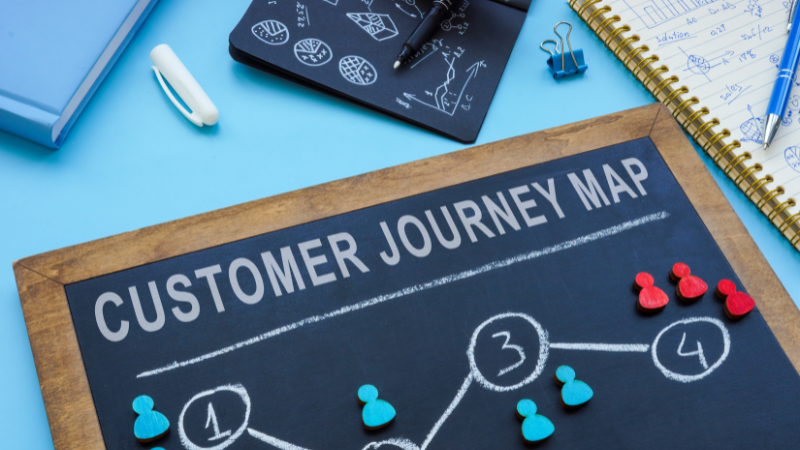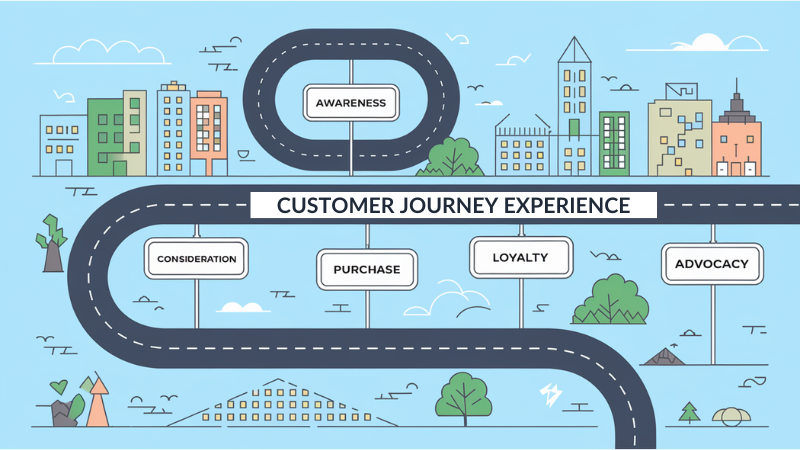Introduction
Welcome to our comprehensive guide on understanding the customer journey experience in today’s competitive business landscape. It’s essential for brands to understand and optimise every interaction customers have with their company to achieve success. From initial contact to final conversion, each customer journey step offers insights to increase satisfaction, loyalty, and revenue.
This post explores the customer journey stages, examining emotions, motivations, and decision-making processes involved. By understanding the entire customer journey, businesses can improve marketing, customer service, and create seamless experiences that ensure customer loyalty. Whether a small business owner or marketer, this guide provides tools to map journeys, identify pain points, and develop strategies.
Get ready to explore the fascinating world of the customer journey experience through this informative guide.
Key Takeaways
- The customer journey consists of five main stages: awareness, consideration, decision, retention, and advocacy
- Understanding the customer journey helps businesses identify pain points, personalise experiences, and build stronger customer relationships
- Customer journey mapping is a continuous process that requires regular updates based on changing customer preferences and market conditions
- Data analysis and customer feedback are crucial for optimising touchpoints and improving the overall experience
- Success measurement through metrics like NPS and customer satisfaction scores is essential for continuous improvement
Table of Contents
- The Stages of the Customer Journey
- Importance of Understanding the Customer Journey
- Mapping the Customer Journey
- Identifying Touchpoints
- Analysing Customer Behaviour and Preferences
- Improving the Customer Journey Experience
- Measuring Success
- Tools and Resources
- FAQ’s
- Final Thoughts
The stages of the customer journey
Understanding the customer journey involves recognising the distinct stages that customers go through when interacting with a brand. These stages typically include awareness, consideration, decision, retention, and advocacy. Each stage presents unique challenges and opportunities for businesses to engage with their customers effectively.
In the awareness stage, potential customers first discover a brand, product, or service through various channels like social media, advertisements, or word-of-mouth. This initial encounter sets the tone for how they perceive the brand moving forward, making it crucial for companies to create a strong first impression.
Once awareness is established, customers move into the consideration stage, where they actively seek more information about the brand and its offerings. Here, they compare options, read reviews, and evaluate the value propositions presented to them.
This stage is particularly important as customers are gathering data to inform their decision-making process. Businesses can leverage this moment by providing informative content, engaging visuals, and clear messaging that highlights the strengths of their products or services. Effective engagement during this stage can significantly influence the customer’s eventual decision.
The decision stage is where customers choose to purchase a product or service. This stage often involves a variety of factors, including pricing, availability, and customer support. A seamless purchasing process can enhance customer satisfaction and encourage repeat business.
Following the decision stage, customers enter the retention phase, where the focus shifts to maintaining a relationship with them. This may involve follow-up communications, loyalty programs, or exceptional customer care to ensure that customers feel valued and appreciated.
Finally, in the advocacy stage, satisfied customers may share their positive experiences with others, becoming brand ambassadors and driving new customer acquisition through word-of-mouth recommendations.
Importance of understanding the customer journey
Understanding customer journeys helps businesses build lasting relationships with customers. The customer journey covers all experiences a customer has with a brand, beyond just purchases. Understanding this journey reveals improvement opportunities and drives growth through better customer satisfaction. Companies can align marketing with customer needs to make interactions more meaningful
Deep understanding of customer journeys lets businesses personalise their communications. Customers expect experiences that match their preferences. By tracking customer interactions, companies can create targeted marketing that addresses specific needs. Personalised approaches improve engagement and build customer loyalty.
Studying the customer journey reveals important behaviour patterns and market trends. Journey data helps businesses spot patterns in purchases and feedback. Companies can use this data to improve products and drive innovation. Understanding customer journeys helps businesses stand out in competitive markets.
Customers want personalised interactions that make them feel valued. Simple changes like using names or customising services can improve engagement. Transparency builds trust in customer relationships. Clear communication about orders and policies helps maintain customer loyalty during challenges.
Mapping the customer journey
Mapping the customer journey helps businesses optimise customer experiences through better understanding. Visualising customer touchpoints gives businesses a complete view of brand interactions.

Journey maps show stages from awareness to advocacy, tracking customer actions and emotions, while visual mapping helps identify improvement areas and engagement opportunities. Organizations should collect insights from customer feedback, surveys, and analytics, and direct customer interviews provide valuable information about their experiences.
Understanding customer emotions and motivations helps create better engagement strategies, and this insight allows businesses to improve customer experiences. Journey maps should be updated as customer preferences change, since organisations need to keep their maps current and effective. Regular journey mapping helps businesses adapt to customer needs, ultimately creating better customer experiences over time.
Identifying touchpoints along the customer journey
Customer touchpoints are critical moments of interaction between customers and brands throughout the customer journey, and understanding these touchpoints helps businesses create better customer experiences.
Touchpoints occur through online and offline channels like social media, websites, and in-person interactions, while each touchpoint shapes customer perception, so businesses must optimise these key interactions.
Businesses should analyse their customer journey maps to find all touchpoints, as they need to identify every potential brand interaction. Customer feedback and analytics reveal the most important touchpoints and customer challenges, and cart abandonment during online purchases may show problems with checkout or shipping options.
Businesses should focus on touchpoints that most impact customer experience, which helps organisations use resources effectively. Regular touchpoint monitoring helps businesses adapt to changing customer needs, ultimately ensuring all interactions create positive experiences.
Analysing customer behaviour and preferences
Analysing customer behaviour helps understand the customer journey, and this analysis examines how customers interact with brands through their habits and preferences. Analytics tools provide insights that improve marketing strategies and customer experiences, while web analytics tools like Google Analytics show website traffic and user engagement.
Understanding page visits and customer drop-off points helps identify website improvements, and this data helps improve website design and content to match customer preferences. Surveys and feedback reveal deeper insights into customer preferences, as organisations learn about satisfaction and customer needs. Analysing feedback helps businesses make better decisions about products and services, ultimately helping create experiences that build loyalty.
Improving the customer journey experience
Enhancing customer journeys requires improving touchpoints and fixing pain points. Gathering customer feedback is the first step.
Feedback through surveys and social media shows what customers like and what needs improvement. Customer input helps businesses make better decisions.

Technology helps streamline processes and improve communication, while CRM systems help businesses manage customer interactions effectively. Chatbots and automated messaging provide instant customer support, and technology integration creates efficient experiences that meet customer needs.
Data analytics helps businesses personalize marketing messages and offerings, as personalisation increases engagement and builds customer loyalty. Organisations should constantly evaluate and improve their customer journey, ultimately creating experiences that keep up with customer expectations.
Measuring the success of the customer journey experience
Measuring customer journey success helps businesses optimise their strategies, and organisations can use various metrics to assess journey effectiveness. Satisfaction scores, NPS, and retention rates show how customers view their brand experiences, while satisfaction surveys help track customer experiences at different touchpoints, and score changes reveal areas needing improvement.
NPS measures customer loyalty and brand recommendation likelihood, and high scores show successful journeys. Businesses should analyse conversion rates and sales alongside qualitative metrics, as tracking behaviour patterns reveals issues in the purchase process. Analytics tools monitor website and customer interaction performance, ultimately helping businesses make better decisions for growth.
Tools and resources for understanding the customer journey
To understand and optimise the customer journey, businesses can use various tools and resources to gather insights and analyse interactions, while customer journey mapping tools like Lucid chart or Smaply help organisations visualise the customer journey and identify key touchpoints and pain points.
These tools provide collaborative platforms for teams to create and share journey maps, improving understanding of the overall customer experience, and analytics software like Google Analytics delivers valuable data on customer behaviour and website performance, helping businesses track engagement, conversions, and key metrics. Analysing this data helps organisations identify which aspects of the customer journey succeed and which areas need improvement, while heat mapping tools like Hotjar show how customers interact with websites, highlighting areas where users face challenges.
Customer feedback platforms like SurveyMonkey or Typeform let businesses gather direct customer input on their experiences through surveys and polls, and incorporating customer feedback helps organisations make informed decisions to enhance the overall customer experience. Using these tools allows businesses to deeply understand the customer journey, ultimately creating more engaging and satisfying experiences for their customers.

FAQs
Q1: What are the main stages of the customer journey?
A: The customer journey consists of five key stages: awareness (when customers first discover your brand), consideration (when they research and compare options), decision (the purchase phase), retention (maintaining the customer relationship), and advocacy (when satisfied customers become brand ambassadors).
Q2: How can businesses effectively map the customer journey?
A: Businesses can map the customer journey by gathering insights from multiple sources including customer feedback, surveys, analytics, and direct interviews. The map should include customer actions, emotions, and thoughts at each stage, creating a visual representation that can be regularly updated.
Q3: What tools are available for analysing the customer journey?
A: Several tools can help analyse the customer journey, including journey mapping software (like Lucidchart or Smaply), analytics platforms (like Google Analytics), heat mapping tools (such as Hotjar), and customer feedback platforms (like SurveyMonkey or Typeform).
Final Thoughts:
To understand and optimise the customer journey, businesses can use various tools and resources to gather insights and analyse interactions, while customer journey mapping tools like Lucidchart or Smaply help organisations visualise the customer journey and identify key touchpoints and pain points.
These tools provide collaborative platforms for teams to create and share journey maps, improving understanding of the overall customer experience, and analytics software like Google Analytics delivers valuable data on customer behaviour and website performance, helping businesses track engagement, conversions, and key metrics. Analysing this data helps organisations identify which aspects of the customer journey succeed and which areas need improvement, while heat mapping tools like Hotjar show how customers interact with websites, highlighting areas where users face challenges.
Customer feedback platforms like SurveyMonkey or Typeform let businesses gather direct customer input on their experiences through surveys and polls, and incorporating customer feedback helps organisations make informed decisions to enhance the overall customer experience. Using these tools allows businesses to deeply understand the customer journey, ultimately creating more engaging and satisfying experiences for their customers.
Speak soon
- How Customer Education Fuels Referrals and Maximises Lifetime Value (CLV) - April 4, 2025
- Referral Success: The Art of Long-Term Referral Relationship Building - March 19, 2025
- 10 Rules of Referral Marketing - February 26, 2025
